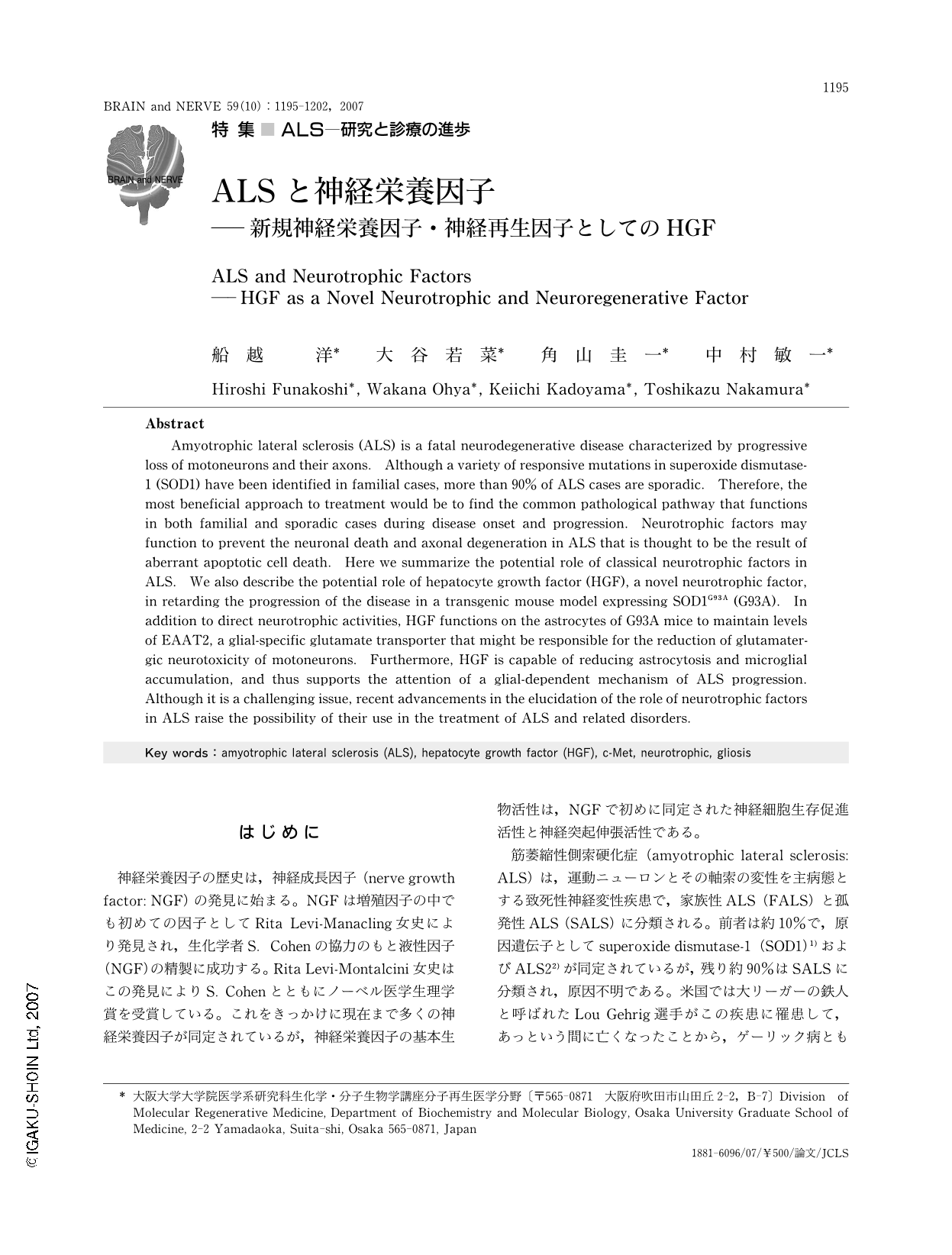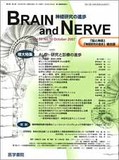Japanese
English
- 有料閲覧
- Abstract 文献概要
- 1ページ目 Look Inside
- 参考文献 Reference
はじめに
神経栄養因子の歴史は,神経成長因子(nerve growth factor: NGF)の発見に始まる。NGFは増殖因子の中でも初めての因子としてRita Levi-Manacling女史により発見され,生化学者S. Cohenの協力のもと液性因子(NGF)の精製に成功する。Rita Levi-Montalcini女史はこの発見によりS. Cohenとともにノーベル医学生理学賞を受賞している。これをきっかけに現在まで多くの神経栄養因子が同定されているが,神経栄養因子の基本生物活性は,NGFで初めに同定された神経細胞生存促進活性と神経突起伸張活性である。
筋萎縮性側索硬化症(amyotrophic lateral sclerosis: ALS)は,運動ニューロンとその軸索の変性を主病態とする致死性神経変性疾患で,家族性ALS(FALS)と孤発性ALS(SALS)に分類される。前者は約10%で,原因遺伝子としてsuperoxide dismutase-1(SOD1)1)およびALS22)が同定されているが,残り約90%はSALSに分類され,原因不明である。米国では大リーガーの鉄人と呼ばれたLou Gehrig選手がこの疾患に罹患して,あっという間に亡くなったことから,ゲーリック病とも呼ばれている神経変性疾患の中でも最も重篤な疾患の1つであり,この疾患を克服できたら他の神経変性疾患も順次克服できるものと考えられている。特に孤発例が大部分を占めるALSはその治療法開発に難渋しており,現時点で有効な治療法がないのが実情である。原因は依然明らかではないものの,FALSとSALSは最終的に運動神経細胞とその神経線維の変性が起こる点で共通している。そこでFALSとSALSに対する治療戦略には,両者の共通病態である神経細胞死抑制と,神経ネットワークの再建にアプローチすることが有利と考えられている。神経栄養因子が神経疾患,中でもALSで特に注目されるのは,この点に理由がある。
本稿では,FALSとSALSの共通病態改善に有望として注目されている神経栄養因子の基本活性と,最近になり明らかとなった新たな生物活性,ならびに最近top journalsに掲載され世界的に注目されている,新しい方法による神経栄養因子臨床試験(clinical trial)の代表例について紹介する。加えて従来の神経栄養因子活性と異なる,独自の活性を持つ新しい神経栄養因子・神経再生因子としての肝細胞増殖因子(hepatocyte growth factor: HGF)について,ALS治療貢献への可能性について紹介する。
Abstract
Amyotrophic lateral sclerosis (ALS) is a fatal neurodegenerative disease characterized by progressive loss of motoneurons and their axons. Although a variety of responsive mutations in superoxide dismutase-1 (SOD1) have been identified in familial cases, more than 90% of ALS cases are sporadic. Therefore, the most beneficial approach to treatment would be to find the common pathological pathway that functions in both familial and sporadic cases during disease onset and progression. Neurotrophic factors may function to prevent the neuronal death and axonal degeneration in ALS that is thought to be the result of aberrant apoptotic cell death. Here we summarize the potential role of classical neurotrophic factors in ALS. We also describe the potential role of hepatocyte growth factor (HGF), a novel neurotrophic factor, in retarding the progression of the disease in a transgenic mouse model expressing SOD1G93A (G93A). In addition to direct neurotrophic activities, HGF functions on the astrocytes of G93A mice to maintain levels of EAAT2, a glial-specific glutamate transporter that might be responsible for the reduction of glutamatergic neurotoxicity of motoneurons. Furthermore, HGF is capable of reducing astrocytosis and microglial accumulation, and thus supports the attention of a glial-dependent mechanism of ALS progression. Although it is a challenging issue, recent advancements in the elucidation of the role of neurotrophic factors in ALS raise the possibility of their use in the treatment of ALS and related disorders.

Copyright © 2007, Igaku-Shoin Ltd. All rights reserved.


